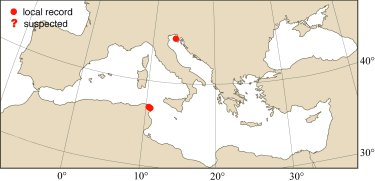
|
Relevant Synonyms
Misidentification
|
|
| photo : Ch. Schubart |
|
SHORT
DESCRIPTION
color :
carapace mottled greenish-brown, small reddish spots on the upper parts of the chelipeds, banded walking legs.
common size :
CL 3 cm. |
DISTINGUISHING CHARACTERISTICS
BIOLOGY / ECOLOGY
habitat : |
|
1st
MEDITERRANEAN RECORD
|

|
|
DISTRIBUTION
|
ESTABLISHMENT SUCCESS
speculated reasons for success :
|
|
|
MODE OF
INTRODUCTION |
IMPORTANCE TO
HUMANS |
|
KEY
REFERENCES
|
|
|